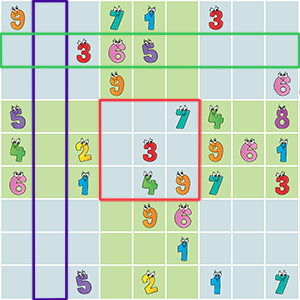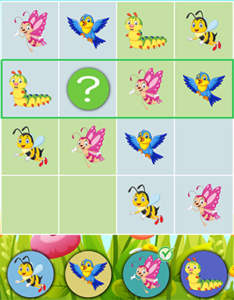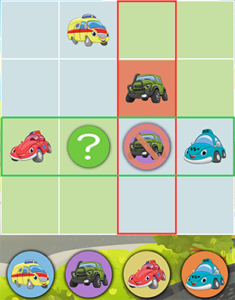Sudoku has always been a brain game for grown-ups. But nowadays, more and more young kids start to tackle Sudoku and greatly benefit from the logic, focus and thinking training that it could bring. So, how hard is it for a pre-schooler to solve a 9×9 Sudoku? There are more than 50 solving techniques, which could seem daunting even for adults. How could a child learn all of these? The good news is that you only need three techniques and mostly just two techniques to solve entry-level 9×9 Sudoku puzzles. Doesn’t it sound much easier? Yes, for young kids it is probably easier than counting from 1 to 20. Let’s dive in!
The Rules of Sudoku
In a classic 9×9 Sudoku, the objective is to fill all cells with digits so that each row (green rectangle), each column (purple rectangle), and each 3×3 block (red square) contain all the digits from 1 to 9. Adjacent blocks are usually identified by different background colors.

Besides classic Sudoku, the blocks of jigsaw Sudoku can have arbitrary shapes. For example, the below board pattern resembles a tulip. Jigsaw Sudoku follows the same rules as classic Sudoku. Furthermore, besides using numbers as pieces, plants, animals and any objects can also be used to add more fun.

Solving Technique I: Full House
Row, column and block are also called houses. Full house simply means that there is only one missing digit and unfilled cell in a house, so just place this last digit on the unfilled cell to complete the whole house. For example, in the left picture of the below, the second row is only missing Bee, and in the right picture, the green block is only missing Semi-Truck. Full House is the easiest solving technique and a five-year-old should be able to understand this without much difficulty.
Solving Technique II: Hidden Single
Hidden Single means with regard to a missing digit in a house, we can cross out all cells until only one unfilled cell left to hold that digit. For example, for the left picture of the below, Jeep is missing from the third row and it cannot be placed on the third cell (because the third column already contains Jeep), so it must be placed on the second one; for the right picture, Satellite is missing from the blue block and it cannot be placed on the cell in the second row (because the second row already contains Satellite), so it must be placed on the cell in the fourth row.
Solving Technique III: Naked Single
Naked Single means in a cell there is only one candidate while all other candidates are ruled out by the existing digits in the row, column and block where the cell resides. For example, in the below picture, the cell at green question mark cannot hold 1 or 4 (ruled out by 1 and 4 in the sixth row); it cannot hold 3 or 6 neither (ruled out by 3 and 6 in the fifth column); and it cannot hold 5 neither (ruled out by 5 in the gray block). So it can only hold 2. Full House is a special case of Naked Single.

It is not difficult to understand Naked Single, but it is harder to spot than Hidden Single. Using paper and pencil to mark candidates can help finding Naked Single. The good news is at most cases you don’t need Naked Single. The first two techniques are enough to solve many Sudoku puzzles.
All the above screenshots come from Cute Sudoku Kids, an iOS app designed to bring fun and intelligence to children while playing. Many children with zero knowledge of Sudoku have learned to solve puzzles through this app. They not only acquire logic and math skills, but also learn to focus and enjoy solving problems through patience and persistence.





